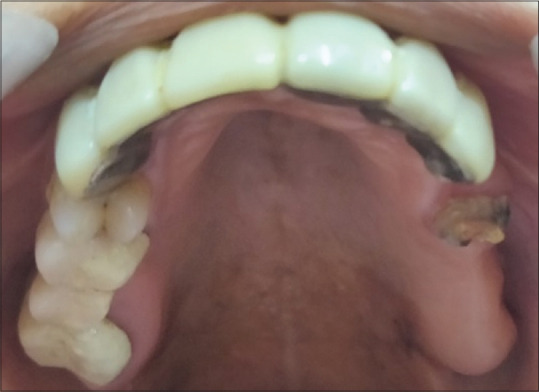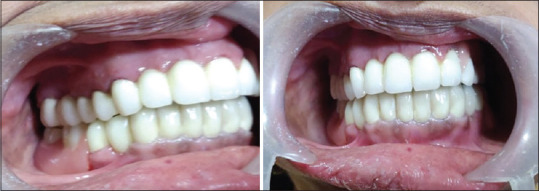Abstract
Rehabilitation of distal extension cases is one of the common challenges in dentistry as fabrication of fixed prosthesis is impossible. For the prosthetic rehabilitation of distal extension, implant-supported prosthesis, cast partial denture, and precision attachment prosthesis can be used. Precision attachment helps in the distribution of masticatory forces, minimizes trauma to abutments and soft tissues, improves the esthetics, and retains proprioception and thus better comfort to the patient. This case report presents the fabrication of precision attachment to retain maxillary and mandibular partial dentures.
KEYWORDS: Distal extension, precision attachment, rehabilitation
INTRODUCTION
Prosthetic rehabilitation of partially edentulous mouth involves multiple techniques such as overdentures, clasp-retained removable partial dentures (RPDs), and RPDs with precision attachments based on the patient's concern and esthetics and anatomical relationships of tissues.[1] A precision attachment is a connecting link consisting of two components for the fixation, retention, and stabilization of prosthesis. One part is fixed to an abutment, and the other is integrated into a RPD to stabilize and retain it. It has male and female parts connecting a RPD to fixed bridgework. The male part of the attachment is a metal receptacle or keyway soldered to fixed crowns, and the female part is attached to the partial denture. This precision attachment replaces occlusal rest, bracing arm, and retaining arm of the conventional clasp retained partial denture.[2] According to Mensor 1971, precision attachments are classified into intracoronal, extracoronal, pushbutton type, bar type, and auxiliary type. Precision attachments are indicated in the areas of esthetic zones, for redistribution of forces, for proper control of loading and rotational forces, for segmenting of the long span bridges, as stress breaker in free end saddles and bridges. Its contraindications include in patients who are sick and senile, patients with severe periodontitis, patients with high caries rate, the presence of inadequate space, and narrow faciolingually.[3,4]
The advantages of precision attachments are better esthetics, improved psychological acceptance of the prosthesis, increased retention and stability, lesser bulk, and reduced incidence of secondary caries, improved vertical support, and better stimulation. The disadvantages are its complexity of design, fabrication procedures, technique sensitive, and need for good oral hygiene.[5]
This case report describes a patient with maxillary bilateral distal extension Kennedy's class I condition which was restored by a cast partial denture retained using an extracoronal castable ball precision attachment with mandibular partial denture.
CASE REPORT
A 54-year-old female reported to a private dental clinic at Adambakkam, Chennai, with complaints of inability to chew food and halitosis. Medical history revealed no systemic complications. Intraoral examination showed that her fixed acrylic with metal backing dentures were broken and worn out with lot of calculus [Figure 1]. It was noted that the patient had missing 11,12,16,23,24,25,26,27,34,36,37,44,46,47. The remaining teeth in the maxillary and mandibular arch were periodontally stable and can be utilized as an abutment for precision attachment, no periapical pathology. An informed and written consent was obtained from the patient.
Figure 1.

Preoperative
First, old bridges were removed. Full mouth scaling and root planing done. All remaining teeth were treated with root canal therapy. Laser-assisted crown lengthening in few teeth was also done [Figure 2]. In this case, the maxillary and mandibular arches exhibited Kennedy's class I classification.
Figure 2.

Tooth preparation
An extracoronal attachment precision ball attachment to support posteriors was used. Diagnostic preliminary impressions were made with alginate and casts poured in the dental stone. A putty matrix was made over the completed diagnostic wax-up for the extracoronal resilient attachment [Figure 3]. Then, casts were mounted on a semi-adjustable articulator with the preestablished vertical dimension and the RPD designed. A cast partial denture base and with acrylic teeth for the posteriors was done. Then, a fixed removable posterior denture placed. All the anterior teeth restored with fixed porcelain fused metal bridge [Figure 4]. The final fit was evaluated and verified intraorally and vertical dimension was not increased. Thus, the esthetics and function improved [Figure 5].
Figure 3.

Wax pattern
Figure 4.

Denture fabrication
Figure 5.

Postoperative
DISCUSSION
An internal precision attachment restoration can be done in a clasp denture for a mouth with few and improperly distributed teeth.[6] The internal precision attachments will improve the esthetics, avoids speech difficulties, better patient comfort, and prevent caries. They also provide normal heat, cold, and taste perception.
There are multiple treatment options for the rehabilitation of partial edentulism. El Charkawi and El Wakad[7] evaluated the changes in retention ability and reported that precision attachments preserve supporting teeth and alveolar bone ridges. In this case report, the abutment selection and the procedures were followed similar to the techniques reported by Jain D et al.[8] and Burns and Ward.[9] The result of this patient is excellent, and the patient is very much satisfied.
CONCLUSION
Thus, attachments retained partial dentures provide the patient with long-term stability and more satisfaction than clasp-retained dentures, and hence, the quality of life of the patient is improved. The proper follow-up after every 6 months is mandatory, and proper hygiene should be maintained by the patient.
Declaration of patient consent
The authors certify that they have obtained all appropriate patient consent forms. In the form, the patient has given her consent for her images and other clinical information to be reported in the journal. The patient understands that her name and initials will not be published and due efforts will be made to conceal her identity, but anonymity cannot be guaranteed.
Financial support and sponsorship
Nil.
Conflicts of interest
There are no conflicts of interest.
REFERENCES
- 1.Ali S, Bhat JT. Precision attachments: A case report. Int J Med Oral Res. 2019;4:21–3. [Google Scholar]
- 2.Arti A, Gupta A, Gaga K, Bhatnagar M, Markose GM, Singh S. Precision attachments in prosthodontics: A review. Int J Prev Clin Dent Res. 2018;5:34–9. [Google Scholar]
- 3.Patel H, Patel K, Thummer S, Patel RK. Use of precision attachment and cast partial denture for long-span partially edentulous mouth – A case report. Int J Appl Dent Sci. 2014;1:22–5. [Google Scholar]
- 4.Mensor MC., Jr Classification and selection of attachments. J Prosthet Dent. 1973;29:494–7. doi: 10.1016/0022-3913(73)90026-7. [DOI] [PubMed] [Google Scholar]
- 5.Shende SA, Bodele SC, Kubasad G, Deshpande A. A cast partial denture with attachment: Boon to preventive prosthodontics – A case report. Int J Adv Res. 2017;5:290–5. [Google Scholar]
- 6.Kumar R, Devi Parameswari B, Annapoorni H. Rehabilitation of partially edentulous patient using Precision Attachment denture – A case report. Ann Prosthodont Restor Dent. 2020;6:162–6. [Google Scholar]
- 7.El Charkawi HG, El Wakad MT. Effect of splinting on load distribution of extracoronal attachment with distal extension prosthesis in vitro. J Prosthet Dent. 1996;76:315–20. doi: 10.1016/s0022-3913(96)90178-x. [DOI] [PubMed] [Google Scholar]
- 8.Jain D, Gupta A, Chhabra S, Sangwan A. Prosthodontic rehabilitation using attachment retained overdenture – Case reports. IOSR J Dent Med Sci. 2015;14:17–23. [Google Scholar]
- 9.Burns DR, Ward JE. A review of attachments for removable partial denture design: Part 2. Treatment planning and attachment selection. Int J Prosthodont. 1990;3:169–74. [PubMed] [Google Scholar]


